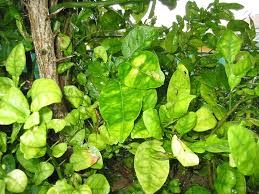SACRAMENTO — The California Department of Food and Agriculture (CDFA) and the United States Department of Agriculture (USDA) have established a 94-square mile quarantine in portions of Riverside and San Bernardino counties following the detection of the citrus disease huanglongbing (HLB), or citrus greening, in a single citrus tree in the city of Riverside. HLB is a deadly disease of citrus plants and closely related species, and can be transmitted from tree to tree by the Asian citrus psyllid.
The quarantine boundaries are on the north, Interstate 10; on the east, Box Springs Mountain Reserve; on the west, Riverside Municipal Airport; and on the south, East Alessandro Boulevard. HLB quarantine maps for Riverside and San Bernardino counties are available online at: www.cdfa.ca.gov/plant/pe/InteriorExclusion/hlb_quarantine.html. Please check this link for future quarantine expansions in these counties, should they occur. Quarantines are already in place for HLB in portions of Los Angeles and Orange counties.
The quarantine will prohibit the movement of all citrus nursery stock out of the area, while maintaining existing provisions allowing the movement of only commercially cleaned and packed citrus fruit. Any fruit that is not commercially cleaned and packed, including residential citrus, must not be removed from the property on which it is grown, although it may be processed and/or consumed on the premises.
Residents are urged to take several steps to help protect citrus trees:
- Do not move citrus plants, leaves or foliage into or out of the quarantine area, or across state or international borders. Keep it local.
- Cooperate with agricultural crews placing traps, inspecting trees and treating for the pest.
- If you no longer wish to care for your citrus tree, consider removing it so it does not become a host to the pest and disease.
CDFA crews have already removed the infected tree and are in the midst of a treatment program for citrus trees to knock down Asian citrus psyllid infestations within 800 meters of the find site. By taking these steps, a critical reservoir of the disease and its vectors will be removed, which is essential to protect the surrounding citrus from this deadly disease.
HLB is a bacterial disease that attacks the vascular system of plants. It does not pose a threat to humans or animals. The Asian citrus psyllid can spread the bacteria as the pest feeds on citrus trees and other plants. Once a tree is infected, there is no cure; it typically declines and dies within a few years.
CDFA, in partnership with the USDA, local county agricultural commissioners and the citrus industry, continues to pursue a strategy of controlling the spread of the Asian citrus psyllids while researchers work to find a cure for the disease.
—California Department of Food and Agriculture
Over 20 new trees in Southern California have been confirmed HLB-positive. The new finds raise the total number of trees with huanglongbing disease found in California to around 100. All of the trees found in the state have been located in residential areas.
 The Citrus Pest and Disease Prevention Program (CPDPP) issued a press release that stated 21 trees in Anaheim, and four trees in Pico Rivera tested HLB-positive. The CPDPP, a program of the California Department of Food and Agriculture (CDFA), stated the current quarantine in Southern California would be slightly expanded in Orange and Los Angeles Counties.
The Citrus Pest and Disease Prevention Program (CPDPP) issued a press release that stated 21 trees in Anaheim, and four trees in Pico Rivera tested HLB-positive. The CPDPP, a program of the California Department of Food and Agriculture (CDFA), stated the current quarantine in Southern California would be slightly expanded in Orange and Los Angeles Counties.
The new detections were found due to intensive surveying that's part of the response program. Highly trained crews sample trees where HLB-positive Asian citrus psyllids have been found. CDFA says their Sacramento facility can process 10,000 samples a month.
All of the detections in California have been residential trees. The CPDPP is currently running an outreach program that involves public service announcements, coordination with officials, and large public events in the quarantine area. The goal is to educate residents on the disease and the insect that spreads it. Go to the CPDPP website to find out more about the disease, insect, and quarantines.
Photo: HLB symptoms
Attached Images:
